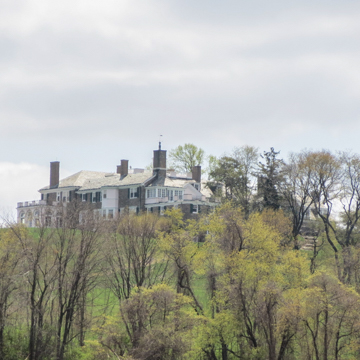Irénée du Pont presided over the family company from 1919 to 1926, years of phenomenal expansion and profitability. He bought four contiguous farms comprising more than 500 acres and began a Colonial Revival house spacious enough for his family of nine children plus six live-in servants. The site was a lofty hilltop with spectacular views across the Brandywine valley. Pittsburgh architect Spahr had been a classmate of Irénée at the Massachusetts Institute of Technology. Construction was of brick faced with Germantown, Pennsylvania, granite; floors were reinforced concrete covered in teak; walls were paneled in oak carved by American Car and Foundry. Metal craftsman Samuel Yellin provided the iron hardware. A garage housed twelve cars. Du Pont collected minerals, and his wife, Irene Sophie, was a horticulturist, so the architect included a museum, solarium, and conservatory. A Maxfield Parrish mural depicting a romantic landscape hangs above a large organ. The basement contained a chemical laboratory and milk-testing facility for the estate's dairy operations. Sophie laid out the gardens with DuPont engineer Albert E. S. Hall. As the twenty-first century began, Granogue remained occupied by Irénée's and Sophie's only son, Irénée du Pont Jr. Following his death in 2023, Pennsylvania's Longwood Gardens acquired the 505-acre Granogue estate.
You are here
Granogue
1921–1923, Albert H. Spahr. South of Smith Bridge Rd. overlooking Brandywine Creek, east of Centreville
Updated By:
Catherine Boland Erkkila (2023)
If SAH Archipedia has been useful to you, please consider supporting it.
SAH Archipedia tells the story of the United States through its buildings, landscapes, and cities. This freely available resource empowers the public with authoritative knowledge that deepens their understanding and appreciation of the built environment. But the Society of Architectural Historians, which created SAH Archipedia with University of Virginia Press, needs your support to maintain the high-caliber research, writing, photography, cartography, editing, design, and programming that make SAH Archipedia a trusted online resource available to all who value the history of place, heritage tourism, and learning.


